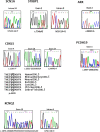Analysis of mutations in 7 genes associated with neuronal excitability and synaptic transmission in a cohort of children with non-syndromic infantile epileptic encephalopathy
- PMID: 25951140
- PMCID: PMC4423861
- DOI: 10.1371/journal.pone.0126446
Analysis of mutations in 7 genes associated with neuronal excitability and synaptic transmission in a cohort of children with non-syndromic infantile epileptic encephalopathy
Abstract
Epileptic Encephalopathy (EE) is a heterogeneous condition in which cognitive, sensory and/or motor functions deteriorate as a consequence of epileptic activity, which consists of frequent seizures and/or major interictal paroxysmal activity. There are various causes of EE and they may occur at any age in early childhood. Genetic mutations have been identified to contribute to an increasing number of children with early onset EE which had been previously considered as cryptogenic. We identified 26 patients with Infantile Epileptic Encephalopathy (IEE) of unknown etiology despite extensive workup and without any specific epilepsy syndromic phenotypes. We performed genetic analysis on a panel of 7 genes (ARX, CDKL5, KCNQ2, PCDH19, SCN1A, SCN2A, STXBP1) and identified 10 point mutations [ARX (1), CDKL5 (3), KCNQ2 (2), PCDH19 (1), SCN1A (1), STXBP1 (2)] as well as one microdeletion involving both SCN1A and SCN2A. The high rate (42%) of mutations suggested that genetic testing of this IEE panel of genes is recommended for cryptogenic IEE with no etiology identified. These 7 genes are associated with channelopathies or synaptic transmission and we recommend early genetic testing if possible to guide the treatment strategy.
Conflict of interest statement
Figures
References
-
- Dulac O. Epileptic encephalopathy. Epilepsia. 2001;42 Suppl 3:23–26. - PubMed
-
- Berg AT, Berkovic SF, Brodie MJ, Buchhalter J, Cross JH, van Emde Boas W, et al. Revised terminology and concepts for organization of seizures and epilepsies: report of the ILAE Commission on Classification and Terminology, 2005–2009. Epilepsia. 2010;51(4):676–685. 10.1111/j.1528-1167.2010.02522.x - DOI - PubMed
-
- Katherine D. Holland BEH. What causes epileptic encephalopathy in infancy? The answer may lie in our genes. Neurology. 2010;75:2. - PubMed
Publication types
MeSH terms
LinkOut - more resources
Full Text Sources
Other Literature Sources


